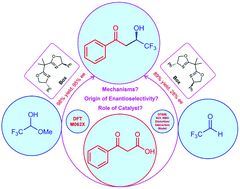Chiral bisoxazoline catalyzed decarboxylative aldol reactions between β-carbonyl acids and trifluoroacetaldehyde hemiacetals as well as trifluoroacetaldehyde: the mechanism, the origin of enantioselectivity and the role of a catalyst†
Abstract
Chiral bisoxazoline can catalyze the decarboxylative aldol reactions between β-carbonyl acids and trifluoroacetaldehyde hemiacetals as well as trifluoroacetaldehyde but with quite different enantioselectivities, in which the reaction involving trifluoroacetaldehyde hemiacetal results in excellent enantioselectivity (95% ee) while that involving trifluoroacetaldehyde results in poor enantioselectivity (28% ee). To uncover their differences, quantum mechanical calculations together with theoretical methods of global reactivity indexes, QTAIM, NCI and distortion/interaction models were applied to these two reactions; the reaction mechanism, the origin of enantioselectivity and the role of bisoxazoline were investigated in detail. For the reaction with 95% ee, it undergoes the processes of decomposition of trifluoroacetaldehyde hemiacetal, nucleophilic addition, decarboxylation and enol–keto tautomerization of the product, and the nucleophilic addition is the rate- and stereo-determining step. Both the distortion energy and weak intermolecular interactions are responsible for the enantioselectivity. For the reaction with 28% ee, it goes through the processes of nucleophilic addition, decarboxylation and enol–keto tautomerization of the product. Chiral bisoxazoline plays a crucial role in increasing the nucleophilicity of β-carbonyl acid in the reaction leading to 95% ee, while such a role is not observed in the reaction resulting in 28% ee. The calculated ee values are in good agreement with the experimental results. The results shown here will provide valuable insights into the understanding of these types of reactions, the design of highly efficient organocatalysts, and related asymmetric reactions.



 Please wait while we load your content...
Please wait while we load your content...